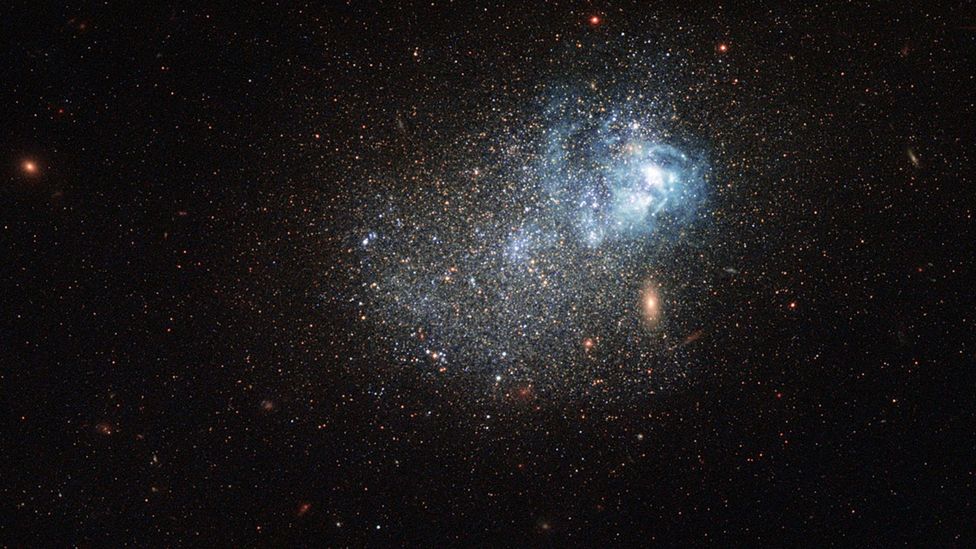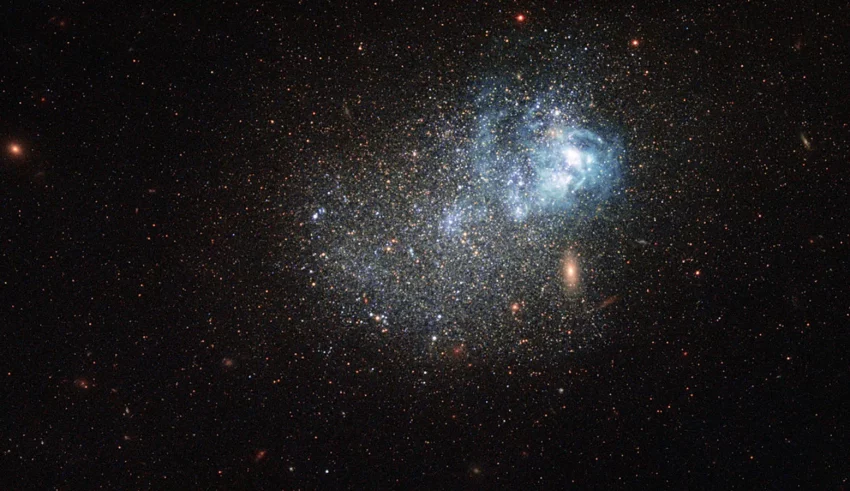In the first few hundred thousand years after our Universe was born, a primordial hum ripped through a plasma of superheated particles.
Scientists are listening in with the hope of gaining new insights about the mysterious force known as dark energy.
Before stars or planets, before black holes and white dwarfs, before even atoms or rays of light, the Universe reverberated with something surprising – sound. This primordial hum moved at more than half the speed of light through a superheated plasma of baryons, photons, and dark matter.
It arose from a tug of war between ancient and powerful fundamental forces generating soundwaves in this electrically charged soup of particles. Then, just a few hundred thousand years into its existence, the plasma disappeared like a morning fog. The Universe fell suddenly, and profoundly silent.
Yet, it is still possible to pick up echos of these first soundwaves that spread out across our early Universe – if you know where to look. The ripples they created in the plasma have left a permanent imprint on the distribution of matter around the Universe. And they are also providing astronomers with clues about one of the deepest mysteries of our Universe today, the mysterious force known as dark energy.
The primordial soundwaves – also known as baryon acoustic oscillations (BAOs) – formed as the particles in the early Universe began to be pulled together by gravity.
“The gravitational pull of dark matter in the early Universe created ‘potential wells,’ pulling plasma inward,” says Larissa Santos, a professor at the Center for Gravitation and Cosmology at the University of Yangzhou, China. The plasma, however, was so hot that it also created an opposing outward force. “Photons created radiation pressure that fought gravity, and pushed everything back out again. This fight created acoustic oscillations – sound waves.”
BAOs burst outward from uncountable potential wells, forming expanding, concentric spheres of sound energy. They crisscrossed each other, sculpting the plasma into dazzlingly complex three-dimensional interference patterns.
Had a human somehow existed in the epoch of “baryon acoustic oscillations” (BAOs), they would have heard nothing. The sounds were around 47 octaves lower than the bottom note on a piano with enormous wavelengths of about 450,000 light years.
This incredibly deep, inaudible rumble travelled through a medium that even our most powerful telescopes is unable to penetrate. The deeper we look into the Universe, the further back into its history we see due to the time it takes for light to reach us. We can only see so far, however, as the electrical charges from unattached protons and electrons in these early stages of the Universe continuously scattered and diffused light, creating an impenetrably random glow. But BAOs created patterns in this medium which rippled outwards, and we can see evidence of these in the Universe today.
The Planck Space Telescope was able to pick up echos of BAOs from the early Universe and scientists have been able to translate them into audible frequencies, in the example below. The hum is composed of a low tone with higher overtones. The whoosing sound that can be heard is an artefact of the processing used to make the sound file.
Then, at about the age of 379,000 years old, the Universe cooled enough for protons and electrons to pair up and form the first neutral hydrogen atoms. The plasma disappeared, leaving the Universe suddenly and dramatically transparent to light. At the same moment, the battle between radiation and gravitation ended, BAOs ceased, and the Universe went silent.
The blast of light energy that now spread through the Universe was so powerful that it still jangles radio telescopes and tantalises physicists more than 13 billion years later as a signal known as cosmic microwave background radiation. The “CMB” is the oldest and most detailed visual record of the early Universe. Here too scientists can see a “fossil record” of the Universe’s first sounds.
“We see them imprinted on the cosmic microwave background, and also in the large-scale structure of the Universe,” says Santos, who is part of a new international radio telescopy project analysing modern echoes of that long-silenced song. “Their signature is found in a small excess in the number of pairs of galaxies separated by a fixed scale of 150 Megaparsecs — around 500 million light years.”
BAO signatures not only hint at what the early Universe sounded like, but also serve as a ruler for measuring the effects of yet another invisible phenomenon: dark energy.
Dark energy causes the Universe to expand. Its effects are everywhere, yet its nature is unknown. Studying the scale of BAO signatures at different distances from Earth tells a story about how dark energy’s effects have changed over the history of the Universe.
“We call it a standard ruler,” says Santos. “We have this fixed scale. We can know by how it appears to vary how the Universe was evolving through time.”
She is part of the “Bingo” radio telescope project, currently under construction in the northeastern Brazilian state of Paraíba. Bingo (which stands for “BAOs from Integrated Neutral Gas Observations”), is attuned to the distinctive radiation signatures of hydrogen, the simplest, oldest, and the most abundant atom in the Universe.

The ripples created in the primordial plasma led to matter clumping together in ways that can still be seen in the way galaxies and stars are clustered
Hydrogen atoms release radiation with a 21-centimetre wavelength – invisible to human eyes, but detectable via radio telescope. This radiation from more distant clouds of hydrogen gets stretched by dark energy, increasing its observed wavelength here on Earth. The further it has travelled, the more stretched out it is.
“You choose a frequency for your radio telescope according to the epoch of the Universe that you want to measure,” says Santos. Bingo is designed to map hydrogen distribution between one billion and four billion light years away – relatively close on the cosmic scale of space and time.
Bingo’s two towering parabolic mirrors reflect this primordial radiation onto an array of 50 flared wave detectors known as “horns”. The telescope’s main moving part is the planet it rests on. The rotating Earth moves the telescope beneath the stars, scanning a strip of sky 15 degrees by 200 degrees.
Using subtle statistical calculations, Santos will analyse its data to locate millions of galaxies, examine their relative distances from one another, and dig deeper into how dark energy affected BAO patterns during that era.
“Bingo will look to the late Universe when dark energy already dominates the expansion. It’s very complementary to other experiments,” she says.
Many of those other experiments are already planned or underway.
Santos also hopes BAOs will reveal even more about the Universe’s past, piercing the 379,000-year-thick wall of plasma
“Hydrogen intensity mapping can in principle measure anything in the Universe between present day and up to the CMB. That is a huge volume to explore,” says Cynthia Chiang, a professor of physics who studies hydrogen density at McGill University in Montreal, Canada. “Bingo and other similar experiments look for the gas that lives inside galaxies. It is a tracer for where the matter is.”
While instruments attuned to relatively close regions interest Chiang, she also craves answers about the rest of cosmic history.
“I take a very greedy approach to this,” she says with a laugh. “I’m putting together an experiment that is tuned to frequencies that correspond to the ‘Dark Ages’. That’s the period immediately following the formation of the microwave background. We have never accessed any cosmology from this time period because it’s very, very hard.”
Between 250 and 350 million years elapsed between the “surface of last scattering” when the baryonic plasma gave way to the CMB, and the “cosmic dawn” when the first starlight shone out. BAOs left clouds of hydrogen clumped in wispy striations, liked an ebbing tide leaving ripples behind in the sand.
Before Chiang can access the 21-centimetre radiation from this era, she needs first to design experiments to filter out more recent signals from our own galaxy that could mask older data.
“This first experiment is not yet going to get at cosmology,” she says. “The goal is to map the Milky Way emissions at these frequencies at a very high resolution so that we know what the sky looks like as a first pass. Then, hopefully, we can subtract that off and get to the cosmology.
“As the name suggests, in the Dark Ages, the Universe was a very dark and boring place. The signal you get then is almost a uniform 21-centimetre emission from this wall of hydrogen. But there are faint fluctuations in the brightness that correspond to the over-densities and under-densities. You get tiny cold and hot spots.”
She says the CMB is like a still photograph capturing (in amazing detail) a pivotal moment in cosmological evolution. Mapping hydrogen density in the Dark Ages, though, would capture the hundreds of millions of years that immediately followed.
“It’s a three-dimensional volume you can probe,” says Chiang. “If you can measure the same sort of information as the CMB but reflected in hydrogen instead, you get tremendously more information, and you can potentially constrain cosmological parameters even more. If we get there, that would be amazing. But that’s a very, very long road.”
Chiang’s planned experiments, alongside the Bingo telescope, add to a growing array of innovative observational instruments laying bare the history of BAOs, the large-scale structure of the Universe, and the invisible dark energy that drives galaxies apart.
“When we measure the sky, we measure everything,” says Santos. “CMB, neutral hydrogen, galaxy point-sources, all this kind of stuff. We must be able to recognise what’s a cosmological signal and what is everything else.”
Santos also hopes BAOs will reveal even more about the Universe’s past, piercing the 379,000-year-thick wall of plasma and providing data on the previous fraction of a second – the Universe’s “inflationary epoch”, during which most cosmologists think space was expanding at a rate faster than the speed of light.
Cosmological inflation is a widely trusted theory of how our Universe got from its tiny, hot, dense, original state to the cosmos we see today. The theory has gone through many incarnations, variations, and simulations. It makes many robust predictions that have been tested and verified, yet there is no direct evidence for it.
“Many, many inflationary theories have been already discarded by our observations,” says Santos. “With the measurements we want to see, we can determine which theories agree best with that measurement and go from there.”
Baryon acoustic oscillations only existed for a few hundred thousand years, but they helped create — and are helping scientists tell — the story of the invisible Universe from its first moment to its last.




























